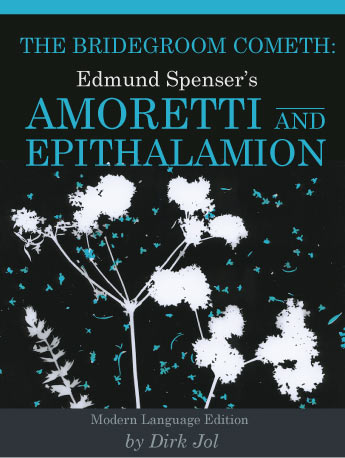The Bridegroom Cometh:
Edmund Spenser’s Amoretti and Epithalamion
→ Biography of Edmund Spenser


Starting at last to make his way in the world, he planned to marry and settle down. Alas, the bride-to-be wasn’t quite as demure and compliant as he had expected her to be. Though his ideas about courtship were not always reciprocated by her, it is clear that they were very much in love.
Edmund Spenser’s sonnet and song cycle, Amoretti and Epithalamion, was first published in London in . He had just completed the first three books of his epic poem, The Faerie Queene, and wrote Amoretti and Epithalamion before continuing with the next three books. It was Spenser’s second marriage (his first wife had died some seven years before), and he wanted to make a gift of this book to his new bride, Elizabeth Boyle.
The book is divided into three parts: a first part of 89 sonnets which deals with Spenser’s courtship, a brief middle part consisting of four epigrams featuring classical mythological characters, and the third part a poem of 24 stanzas, one for each hour of the wedding day. What is remarkable about the Amoretti poems is their highly complex structure. They reflect Petrarchan models on which English sonnet sequences were based, but they also exhibit an Elizabethan preoccupation with numerology. The theme of each of the sonnets corresponds to a day in the lectionary calendar of the 1559 Book of Common Prayer. Explore these themes in the readings found below.
The Modern Language Edition of Amoretti and Epithalamion will appeal to readers who have difficulties with early modern English but still want to gain a strong grasp of the contents on first reading.
Edmund Spenser’s Amoretti and Epithalamion was first published in , and is the source of the selections below.
Each of the 24 stanzas of the Epithalamion corresponds to one of the hours of the wedding day, beginning at midnight and ending just before the following midnight. Each hour-stanza is, in turn, divided into four quarter-hour stanzas.
Between the Amoretti and the Epithalamion, Spenser has interposed a set of four epigrams, together called the The Anacreontic Verses. These brief verses are ostensibly about Cupid as a little love god, but they are actually a commentary on both the preceding Amoretti and the succeeding Epithalamion.
You may purchase an ebook (epub or mobi) of the entire 1595 version in the original wording at a nominal cost of US $1.99 by clicking on the following button:
Contemporary literary critics like the late Kenneth J. Larsen think Spenser used the lectionary readings from the Church of England’s Book of Common Prayer to inspire the daily sonnets that he dedicated to Elizabeth Boyle. The order of the readings below follows the ‘Kalendar’ given in the 1559 edition of the lectionary, the one which Spenser most likely used. The readings themselves are from the 1560 edition of the Bible published in Geneva by Protestant British expatriates, with which Spenser was also likely to be familiar. Readers will note that duplicate readings are given for Sonnets 70 and 83, and that there is a gap of about one month in the sequence after Sonnet 75.
Kenneth J. Larsen, Edmund Spenser’s Amoretti and Epithalamion: A Critical Edition, Tempe, Arizona: Medieval & Renaissance Texts & Studies, .
Alastair Fowler, Triumphal Forms: Structural Patterns in Elizabeth Poetry, Cambridge: Cambridge University Press, .
Alexander Dunlop, Introduction to Amoretti and Epithalamion, in William Allan Oram et al., eds., The Yale Edition of the Shorter Poems of Edmund Spenser New Haven: Yale Univ. Press, .
Alexander Dunlop, The Unity of Spenser’s Amoretti, in Alastair Fowler, ed., Silent Poetry: essays in numerological analysis London: Routledge and Kegan Paul, .
William Clarence Johnson, Spenser’s Amoretti: Analogies of Love, Lewisburg: Bucknell University Press, .
Donna Gibbs, Spenser’s Amoretti: A Critical Study, Aldershot, Hampshire: Scolar Press, .